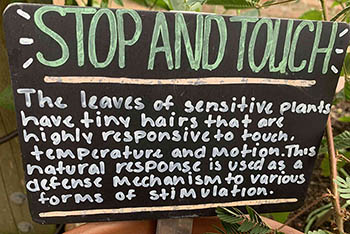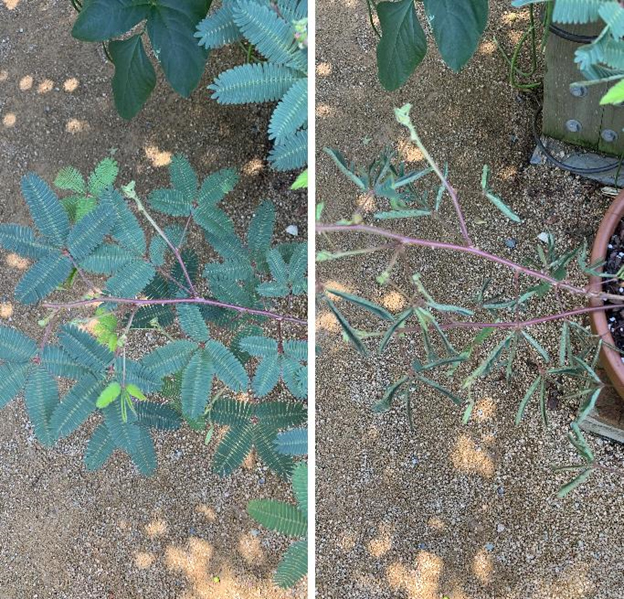Garden Talk
Horticultural Highlight: Sensitive Plant
In this series, the staff of Duke Gardens highlights plants you’ll find within our 55-acre living collection. This week, summer horticulture intern Leighann Murray introduces visitors to a plant they are encouraged to touch in the Charlotte Brody Discovery Garden.
Botanical name: Mimosa pudica
Common name: Sensitive plant
Family name: Fabaceae (Pea Family)
Native range: Central and South America
Location in Duke Gardens: Charlotte Brody Discovery Garden
USDA Hardiness Zones: 7-13

If you have had occasion to touch the sensitive plant in the Charlotte Brody Discovery Garden, then you know how accurate its namesake is! The sensitive plant, Mimosa pudica, is famous for its quick foliar movement, prickly stems and soft, pink, round blooms.
The sensitive plant's botanical name, Mimosa pudica, gives an obvious clue to the type of movement this plant exhibits under stimulus. The genus Mimosa, in ancient Greek, means to imitate or mimic. The specific epithet, pudica, comes from Latin and means to shrink back or be bashful. So if we combine these two terms, we get a plant expected to imitate shrinking back, which is a very accurate summary of the sensitive plant's response to certain stimuli.
Mimosa pudica can close its leaves because its compound leaves fold over one another. This type of movement is seismonastic, which is a plant's physical response to any stimulus, whether it be pressure, heat or lack of sunlight. These stimuli can come in many forms, but the sensitive plant will most likely curl in and shrink back in on itself when touched, shaken, watered or deprived of sunlight. This seismonastic movement is one of the plant's primary defense mechanisms against hungry herbivores. The plant can feel this touch in the first place due to tiny hairs called trichomes that cover the surface of the plant's leaves. But whether this touch comes from a curious child or a routine watering, the sensitive plant knows no difference and momentarily closes its leaves.
The amount of time the leaves stay closed varies based on the intensity of the stimulus. The rougher or more heavy-handed your treatment of the plant, the more quickly it will close up on you. But this is to be expected. In the plant's defense, it does have sensitive in its name.
Mimosa pudica also has quite a reputation abroad. In tropical parts of the world, the sensitive plant is considered invasive by the Global Invasive Species Database. It has become a serious weed in soybean, sugar cane and corn fields, where it is a threat to both plant and human communities. So while we can enjoy this plant’s entertaining foliage and powdery pink blooms in cultivation, this plant can cause more destruction in other regions than its appearance would suggest.
Photos from top to bottom: Close-up of sensitive plant leaves in the Charlotte Brody Discovery Garden, and a sign inviting visitors to touch it, by Orla Swift; sensitive plant leaves before and after contact, by Leighann Murray; video by YouTube creator 99 Chemicals.







